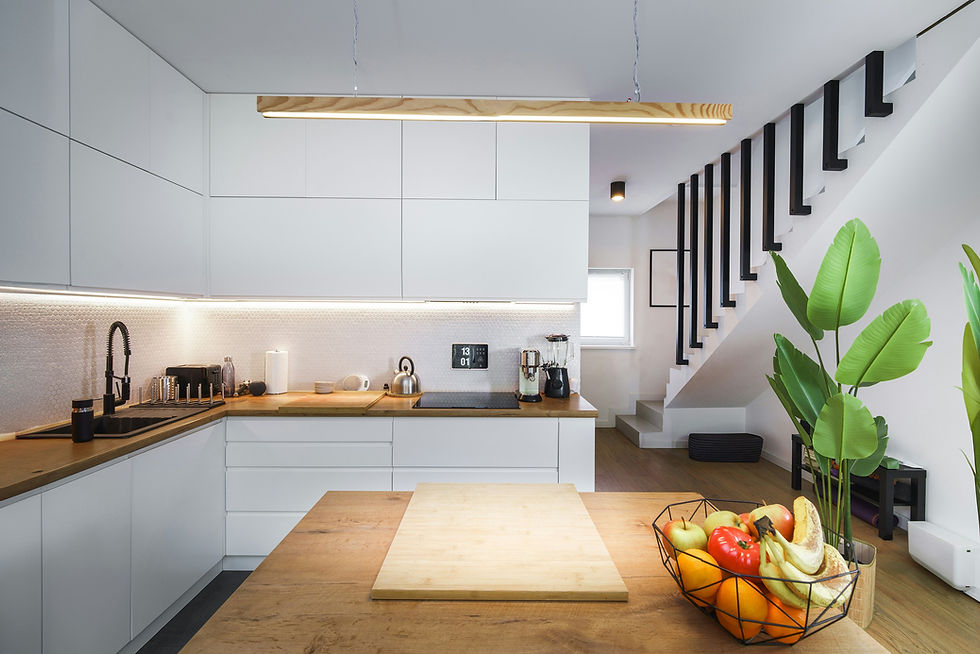Integrating Smart Home Technology into Architectural Design
- Karenna Wilford

- Jul 11
- 2 min read
Smart home technology has evolved from a luxury to an architectural essential. As clients seek homes that are not only stylish but intelligent, integrating tech from the design stage ensures seamless results. At Karenna Wilford Architects, we help clients across Sussex achieve beautifully connected living through thoughtful home automation design. Here's how to incorporate smart systems without compromising your home's aesthetic or character.

1. Designing for Seamless Integration

The earlier technology is considered, the better the outcome. Designing smart systems into the fabric of a home prevents retrofitted clutter and enables cleaner, more coherent spaces.
Centralised control hubs can be neatly housed in service cupboards.
Built-in wiring for sensors, speakers and control panels ensures minimal visual impact.
Discreet devices such as flush-mounted keypads or invisible speakers blend into bespoke joinery and finishes.
Our designs prioritise concealed infrastructure that complements modern architecture tech.
2. Smart Lighting and Scene Setting

Lighting defines a home’s mood. Integrated smart lighting systems allow you to tailor brightness, colour temperature and timing to suit every moment.
Zoned lighting for kitchens, dining, and living areas enhances function and ambience.
Automated schedules mimic presence while you're away, enhancing security.
Smart switches and sensors respond to movement and daylight levels.
3. Climate Control and Energy Efficiency
Heating and cooling systems are key to comfort—and cost. Smart controls help optimise both.

Zoned underfloor heating and smart thermostats regulate each room individually.
Integration with MVHR systems improves air quality and reduces energy waste.
Automated blinds or rooflights respond to external temperatures and sunlight.
These features are particularly useful in Sussex homes where efficient design supports sustainability goals.
4. Security and Access Control
Modern security solutions enhance safety without the need for unsightly hardware.

Smart doorbells offer video and audio access from your phone.
Biometric locks or fob entry can be integrated with alarm systems.
Discreet CCTV cameras tucked into architectural detailing provide peace of mind.
Remote access means you can monitor or control your home from anywhere in the world.
5. AV and Entertainment Systems

Enjoy seamless entertainment experiences with integrated AV systems that match your lifestyle.
Multi-room audio allows music to follow you from kitchen to garden.
Home cinema setups can be built into loft conversions or extensions.
Concealed speakers in ceilings or cabinetry preserve clean lines and acoustics.
All systems can be controlled via apps or voice, reducing the need for visible remotes or cables.
6. Adaptive and Future-Proof Design

Technology moves fast—but well-considered architecture adapts.
Modular control systems can be upgraded as new devices emerge.
Extra conduits and voids in walls allow for future cabling.
Open API systems integrate easily with future third-party innovations.
At Karenna Wilford Architects, we future-proof smart homes in Sussex so they grow with your needs.
Smart home technology, when paired with intelligent design, can elevate not just how your house functions, but how it feels to live in. Whether it’s mood lighting, climate control or security, every detail should support your lifestyle with elegance and ease. Ready to explore the possibilities of smart homes in Sussex? Get in touch to begin your journey with Karenna Wilford Architects.




Integrating smart home technology into architectural design enhances both function and style. With smart home installation services, homeowners can seamlessly incorporate lighting, climate control, security, and entertainment systems from the start. This ensures a clean, future-proof, and energy-efficient home that is both intelligent and aesthetically pleasing.